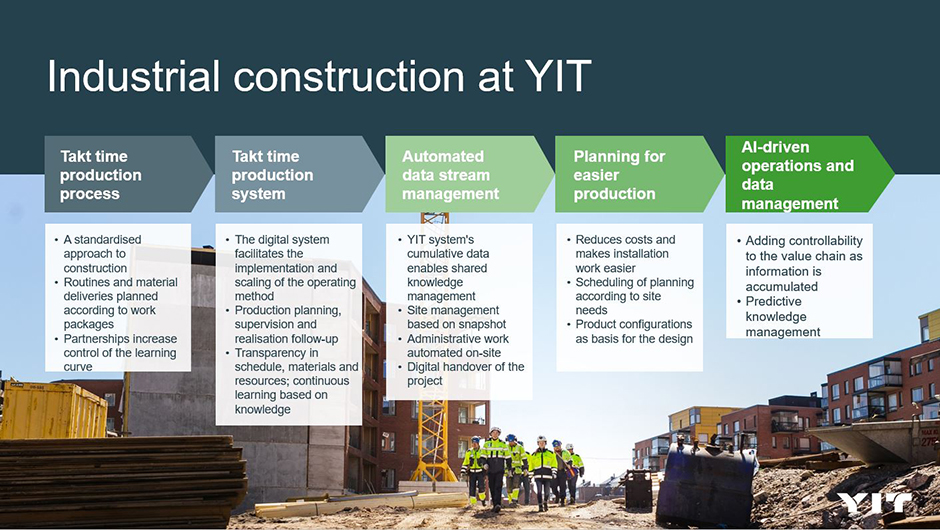Sustainable data centers as a service
- Traffic
- Work
- Construction
- 6/6/2023
Digitalisation promotes the quality and safety of construction
In the future, digital 3D plans can be converted into takt time production schedules, automated material orders for the site and a basis for the maintenance of the entire building. According to YIT’s digital developers, the best benefits of digitalisation are achieved when shared information is utilised by the entire construction chain, from project development to building maintenance.
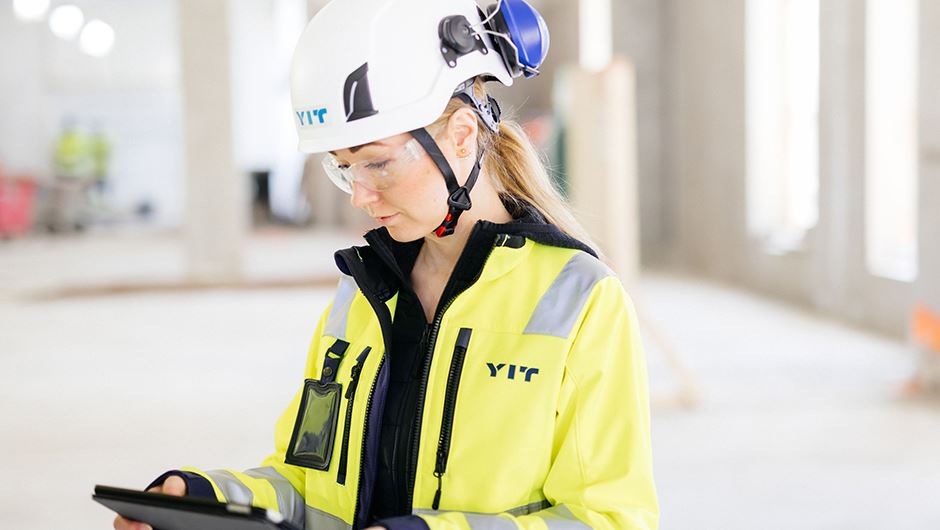
Planning based on BIM (Building Information Model) is already a part of YIT's usual housing production, but in the future, the data from building information models will be utilised much more efficiently than at present. The data can easily be used to form various cost calculations, schedules, energy calculations or simulations. The Building Information Model can also be utilised in the use and maintenance phase of the building.
“We are currently piloting new digital Common Data Environments that have already yielded great experiences in our CEE countries,” says BIM Architect Teemu Kangasmäki.
These successors to today's digital project banks make the planning phase interactive. When the software of the architect, structural designers and technical building systems designers is directly connected to a Common Data Environment, the planning can be managed more efficiently and the plans can be immediately coordinated.
“Through the Common Data Environment, people can communicate and comment on the plans without emailing back and forth, and the entire planning history remains in the system for everyone to see,” Kangasmäki says.
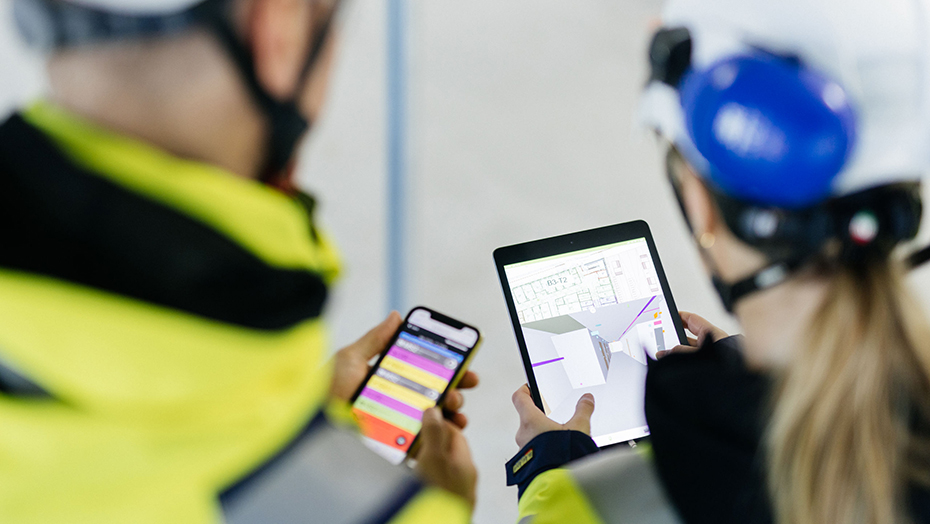
Development Engineer Mikael Österman demonstrates libraries that contain information on the material consumption and workloads of building elements. With the help of the libraries being prepared, the standardised building elements in the Building Information Model are translated into numbers of pieces, working hours and, finally, euros. This way, the BIM can serve as a starting point for the planning of the entire production, from cost calculations to the preparation of schedules.
“In the future, the entire process may be digital. The information about what is needed at the construction site is automatically transferred from the construction site's schedule to the material management system,” Österman envisions.
“The next interface then delivers the order to the supplier's system, and when the goods have been delivered on time to the construction site, the acknowledgement of receipt also accepts the goods for invoicing.”
Development Manager Arto Ylikangas promotes YIT's takt time production and the digitalisation of material management. Rapidly increasing takt time production brings industrial processes and the Lean philosophy to construction sites. The automation of material flow management with digital tools is an essential prerequisite for the transition to time-critical takt time production.
“In the past, best practices easily remained the know-how of individual people or individual construction projects. With digitalisation, the best competence can be made available to the entire YIT,” Ylikangas says.
Digital tools and takt time production methods are intended to boost the productivity development that has stagnated in the construction industry. Together, new industrial operating processes and digitalisation enable a huge leap in productivity.
Improving the quality and safety of construction
The new ways of working can already be seen in the everyday life of construction sites. Digital developers have experienced this personally on sites using takt time production.
“Takt time production improves the quality. Quality assurance becomes routine when the work phases and schedule are carefully planned,” Österman says.
At the same time, YIT sites have started to increasingly use the quality management field tool Congrid. Now, foremen use their phones to record quality observations at the site.
“The data is immediately digitally archived for our benefit and that of posterity,” says Construction Manager Juuso Rapeli.
Rapeli is currently responsible for a 365-apartment block in Koskela, Helsinki. At the construction site, the reviews and inspections defined by the quality matrix run quickly.
When paper, pen and sticky notes are replaced with software that makes everyday life at the construction site easier, it is still possible years later to check from the archive's images whether, for example, the pipes under the tiling are tilted and supported correctly.
“This is an example of prime-quality construction which we need to be able to prove,” Rapeli says.
The repair of small dents before the handover of the building will also be easier. Phone images of repair needs with location data are automatically sent from the system by email to the painter's worklist.
“Congrid has enabled a major digital leap in production,” confirms Arto Ylikangas who previously worked as a quality service overman.
“It is seen as a tool that makes work easier, and even older professionals are happy to use it. ”
Ylikangas also feels that takt time production and the new tools improve quality and safety. It appears that the need for repairs during the warranty phase has decreased at takt time production sites.
“In one of the occupational safety competitions held by the housing unit, the top three sites were all takt time production sites,” says Ylikangas.
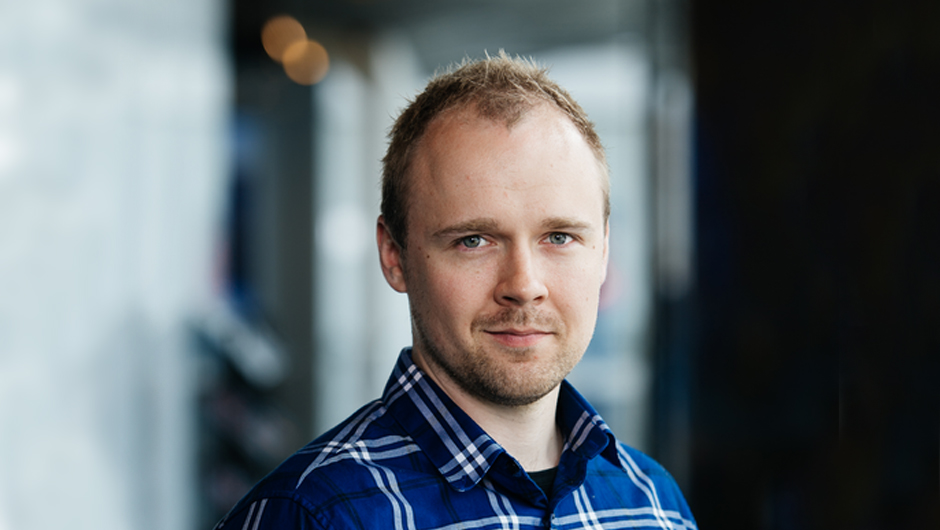
Juuso Rapeli, Construction Manager at YIT.
BIMs utilised in construction
As a representative of production, Juuso Rapeli is already looking forward to the moment when the utilisation of designers' BIM models in production planning and scheduling becomes part of everyday production.
With the help of BIMs, it is also possible to coordinate technical building systems and structural plans more closely as early as the planning stage. This dramatically reduces the number of problems to be solved at the construction site.
In order to achieve this, digital developers still have a lot of work to do. BIM Architect Kangasmäki is responsible for the beginning of the digitalisation pipeline. In order to fully tap into the benefits of building information modelling, plans from different parties must follow common rules.
“I direct designers to create BIMs that can be directly linked to our methods,” Kangasmäki says.
In order for the benefits of digitalisation to be fully utilised, production must also be well standardised. YIT's industrial construction method focuses on the efficiency of the entire production chain. The transition to takt time production is an important part of industrial construction. The entire partner network must also be committed to the change.
“The greatest benefit of digitalisation comes when the whole chain around the project makes use of it,” says Juuso Rapeli.
Discussions are currently taking place with suppliers and subcontractors on the utilisation of BIMs and the automation of data transfer.
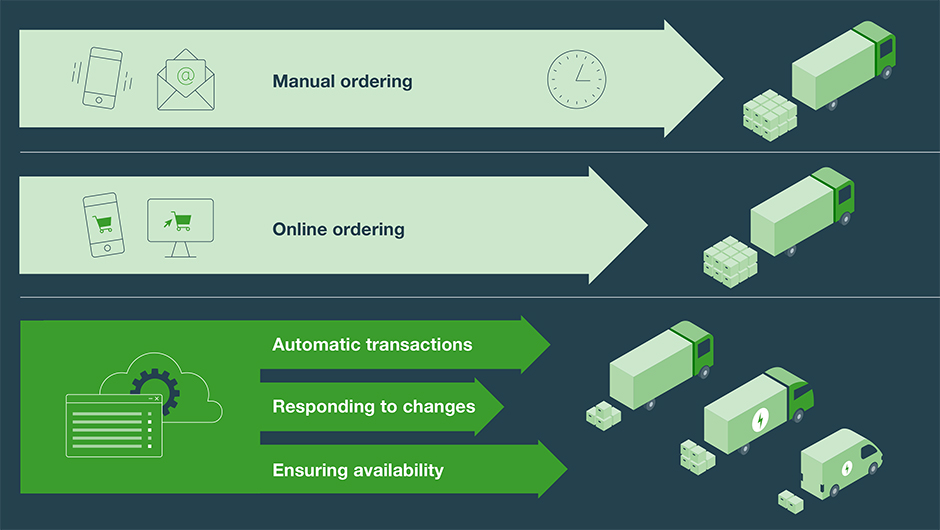
Rapeli says that during his 14-year career at YIT, digitalisation has taken major leaps forward. Nowadays, for example, on-site induction is partly handled in advance online. A digital, always up-to-date plan bank also makes the life of the construction site easier compared to the previous paper folders.
“Digitalisation makes the time spent at the construction site more efficient,” Rapeli says.
Even though the digitalisation of the construction industry is still in the development phase, the current tools are already acting as a major driving force.
“We just need to create shared operating methods, get everyone to use them and start developing the tools together,” says Rapeli.
Teemu Kangasmäki does not expect digitalisation to make cost calculations, scheduling or procurement happen with a push of a button. “However, it is clear that standardised working methods and the automation of data streams make life easier for builders.
They create the conditions for us to be able to make better decisions more easily.”
Digitalisation of the infrastructure sector | YIT.fi
YIT to adopt building information models across the board | YIT.fi
Small digitalisation vocabulary for construction
Building Information Model (BIM) is a set of information about the entire life cycle of a building and the construction process in digital form. The BIM includes the 3D layout of the building as well as information about the properties of the building, its processes and building elements. The data can easily be used to form various cost calculations, schedules, energy calculations or simulations. The Building Information Model can also be utilised in the use and maintenance phase of the building.
The Common Data Environment (CDE) of a construction project is a platform for gathering information during planning, construction and use.
Industry Foundation Class (IFC), a standard for sharing information in the construction industry.
Industrial construction
At YIT, industrial construction refers to a standardised operating method, the information obtained from which is used to continuously improve the end product and operating method.
Takt time production is a production control system that originates from the manufacturing industry. Takt time production is based on Lean thinking which focuses on abandoning unproductive activities while reducing turnaround times, cutting back on costs and improving quality. In takt time production, the project is divided into work packages of the same duration, which follow each other from one takt time area to another without interruption. Takt time production planning utilises the data and Building Information Models produced in construction planning.
Last Planner is a production planning method that focuses on short-term planning and control of the construction phase.
Congrid is a piece of software used at many YIT sites for site management. The application enables sharing, for example, quality inspections, occupational safety measurements and observations, including floor plans, in real time to all parties involved in the construction process.
Dalux is a piece of BIM software and a Common Data Environment.
